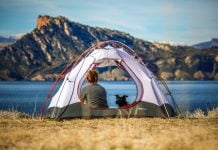Hiking works a lot of muscles in your body. It gives a full-body workout. You use your legs a lot, especially on uphill walks and rough paths. But, you also work many other muscles. This builds strength, gives you more energy, and helps with overall health.
When you hike, your whole body gets involved. Climbing up and walking on trails uses your core, arms, and legs. This is why hiking is good for every part of your body. It gives you a strong and balanced physique. Hiking is not only fun but a great way to stay fit.
Hiking is great for staying healthy. It makes your muscles in the body work hard. This shows how hiking is a key part of getting and staying fit. We will look at all the different muscles that hiking helps and the good things it does for those who do it often. So, let’s dive into how hiking is a super exercise for our bodies.
Key Takeaways
- Hiking is a comprehensive full-body exercise.
- Improves strength and endurance through diverse muscle use.
- Enhances core stability and upper body strength, in addition to the lower body.
- Contributes to overall fitness and well-being.
- Suitable for varying fitness levels and adaptable to different terrains.
Engaging the Lower Body: Hiking for Leg Strength and Endurance
Hiking improves our lower body muscles worked in hiking. It helps our hearts and strengthens our legs. As we hike up and down, our thighs and backside muscles get a big workout. This makes them stronger and helps us go further without tiring as easily.
Quadriceps: Frontline Warriors of Uphill Strides
The quadriceps are in the front of our thighs and help us a lot when we climb. They’re the main workers when we go up slopes. Hiking makes them stronger and helps us stay more stable. This means we’re less likely to get hurt and can hike better for longer.
Hamstrings and Calves: Propelling You Forward on Every Trail
Our hamstrings, found at the back of our thighs, and calves are super important too. They work together with the quadriceps to push our bodies forward. They get a lot of exercise on bumpy trails, making them stronger and more flexible. This makes it easier to keep our balance and move fast on tough paths.
Glute Muscles: The Power Behind Steep Climbs
The gluteal muscles, including the gluteus maximus, are key for hikers, especially on steep parts. Benefits of hiking for glutes include making our lower back and pelvis more stable. This reduces the pressure on our legs and lowers the chance of getting hurt. Plus, our backside gets firmer, and we can keep going longer.
| Muscle Group | Role in Hiking | Benefits |
|---|---|---|
| Quadriceps | Knee and hip extension during uphill climbs | Increased strength and stability |
| Hamstrings and Calves | Propulsion on uneven terrains | Enhanced endurance and flexibility |
| Glute Muscles | Supports pelvis during steep climbs | Better muscle tone and stamina |
Core Strength and Stability: How Hiking Enhances Your Midsection
Hiking does more than just strengthen your legs. It also greatly boosts your core muscles. These include the abs, obliques, and low back. These muscles keep you steady and in control during exercise. Hiking works them a lot because the ground is often uneven. This helps build not just your core, but also your overall strength and balance.
Hiking is great for your core because it needs a lot of stabilization. Think about those uneven trails. Your body needs to adjust to stay upright. This makes your midsection stronger. Plus, being stable on hikes helps your posture every day. Hiking on different trails also gives your core a lot of variety. This makes it stronger and more enduring.
Regular hikes have a big impact on your core. They leave you more stable and in control of your posture. These benefits help more than just your hiking. They can improve other sports and daily tasks. Each hike step you take is a step towards a stronger core. This shows how powerful hiking’s full-body effects can be.












































